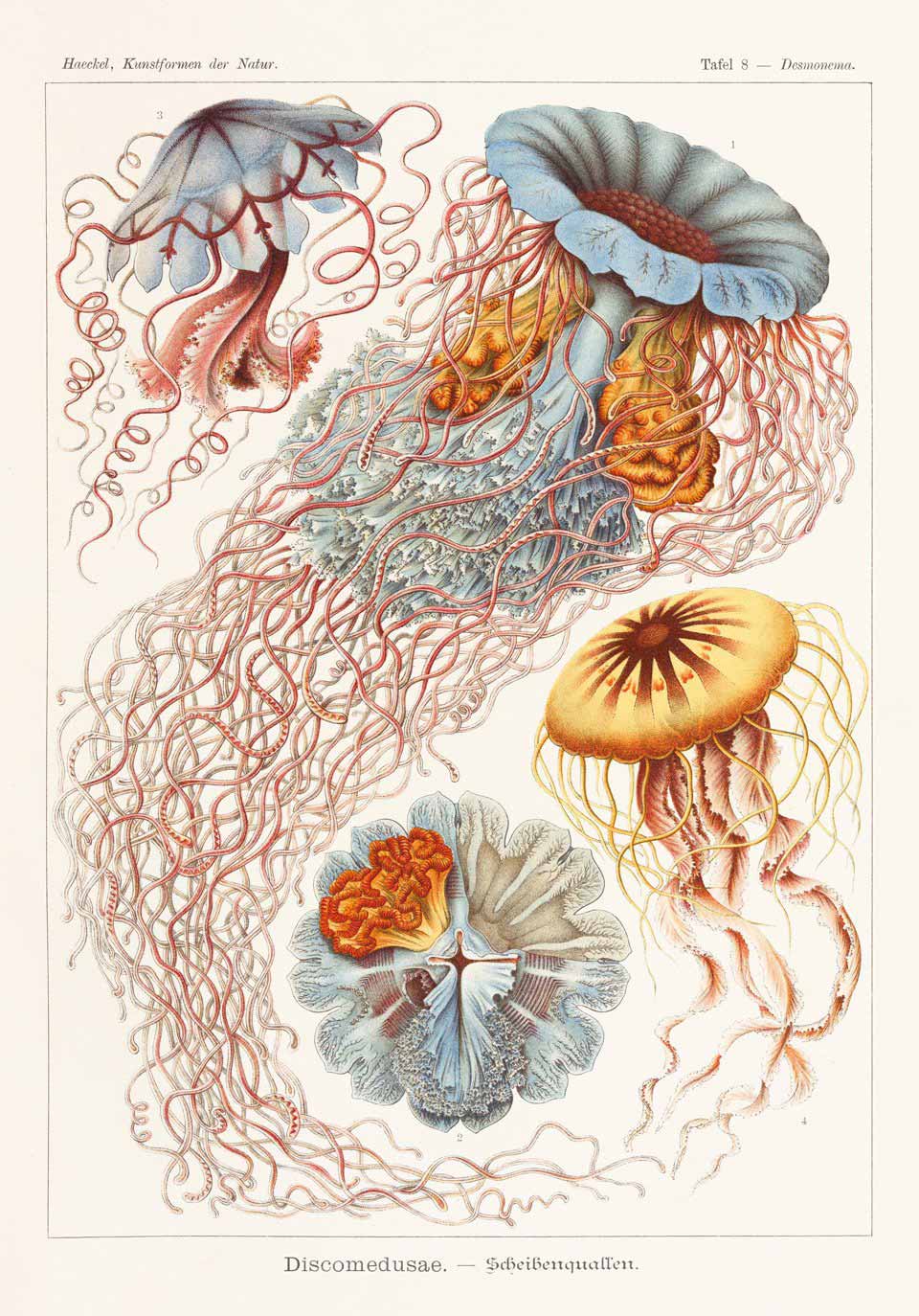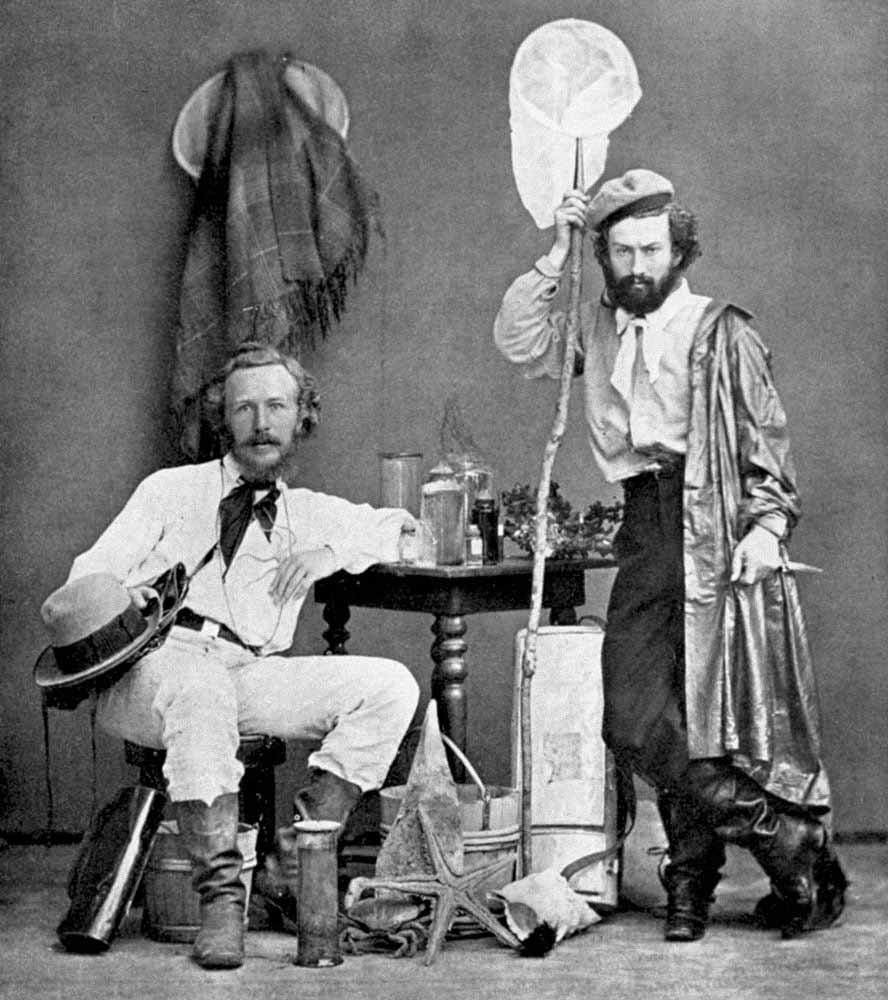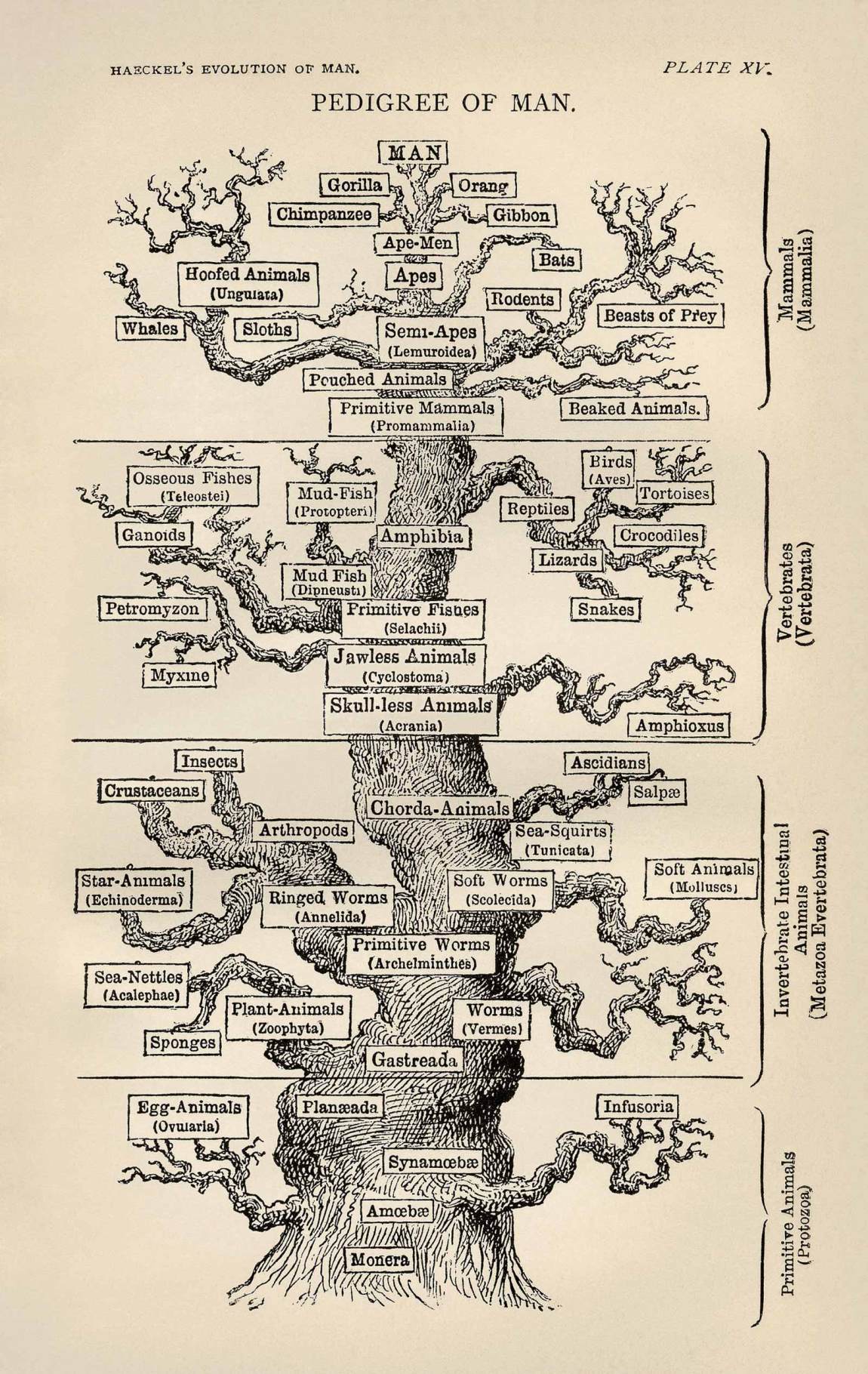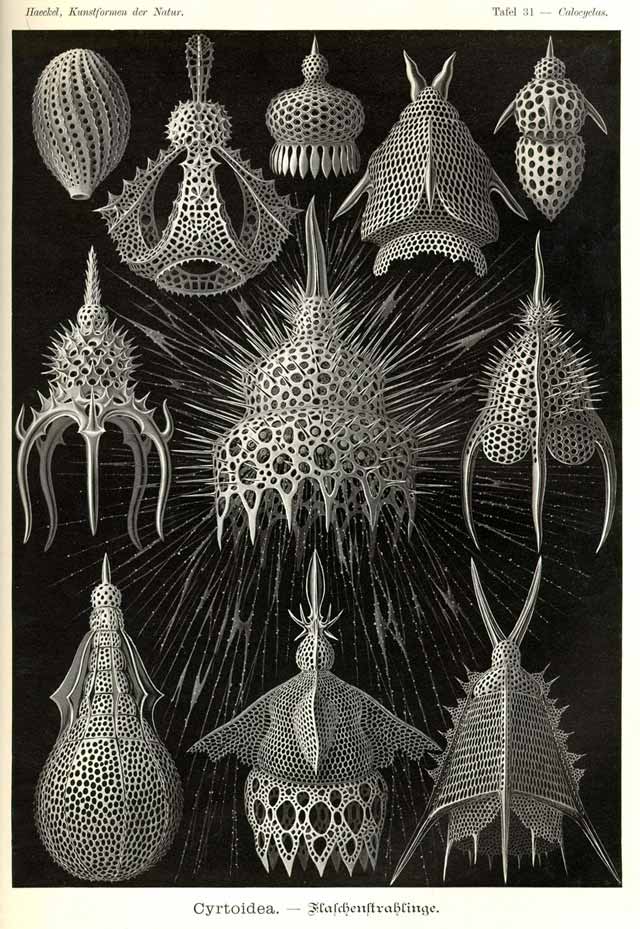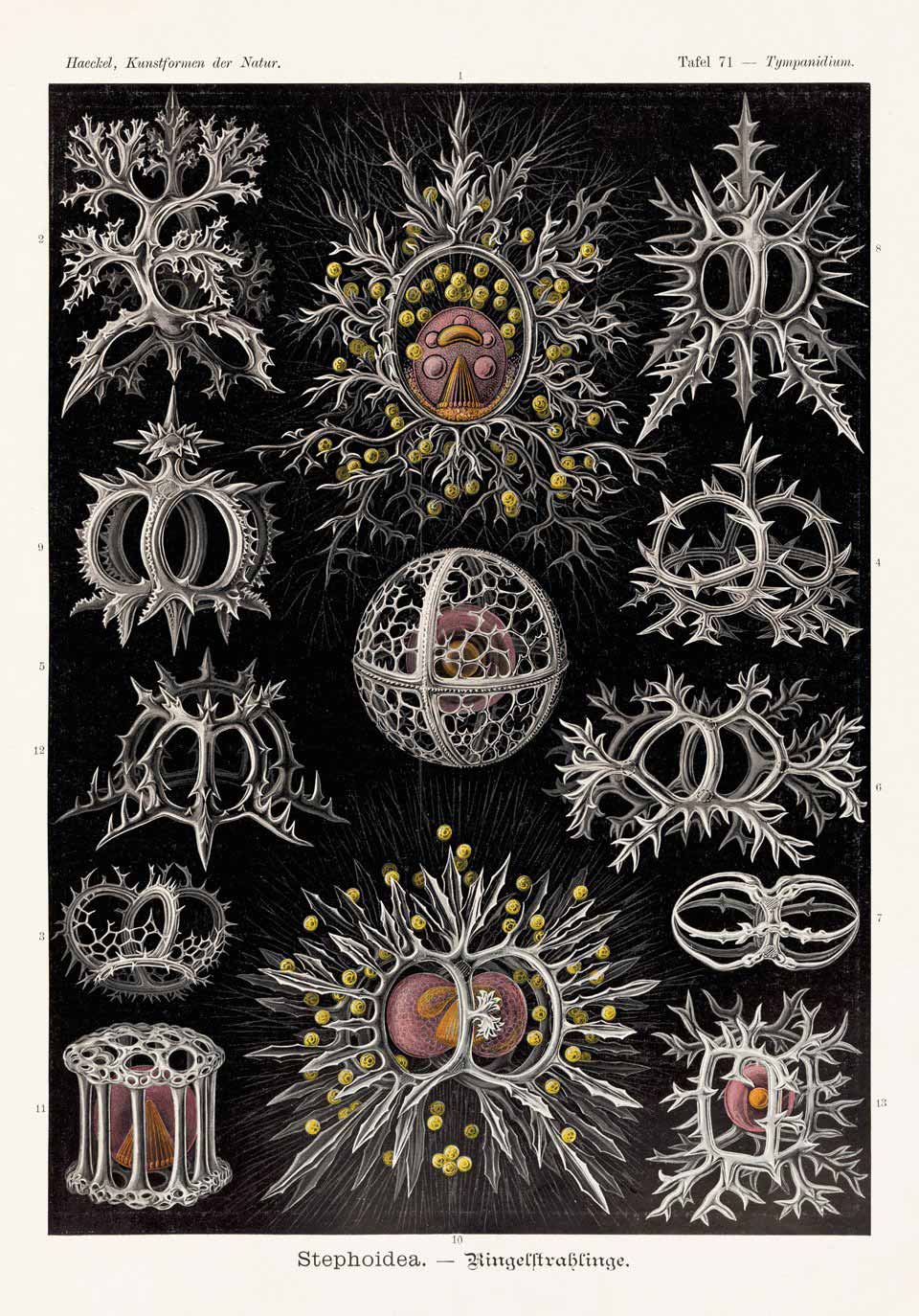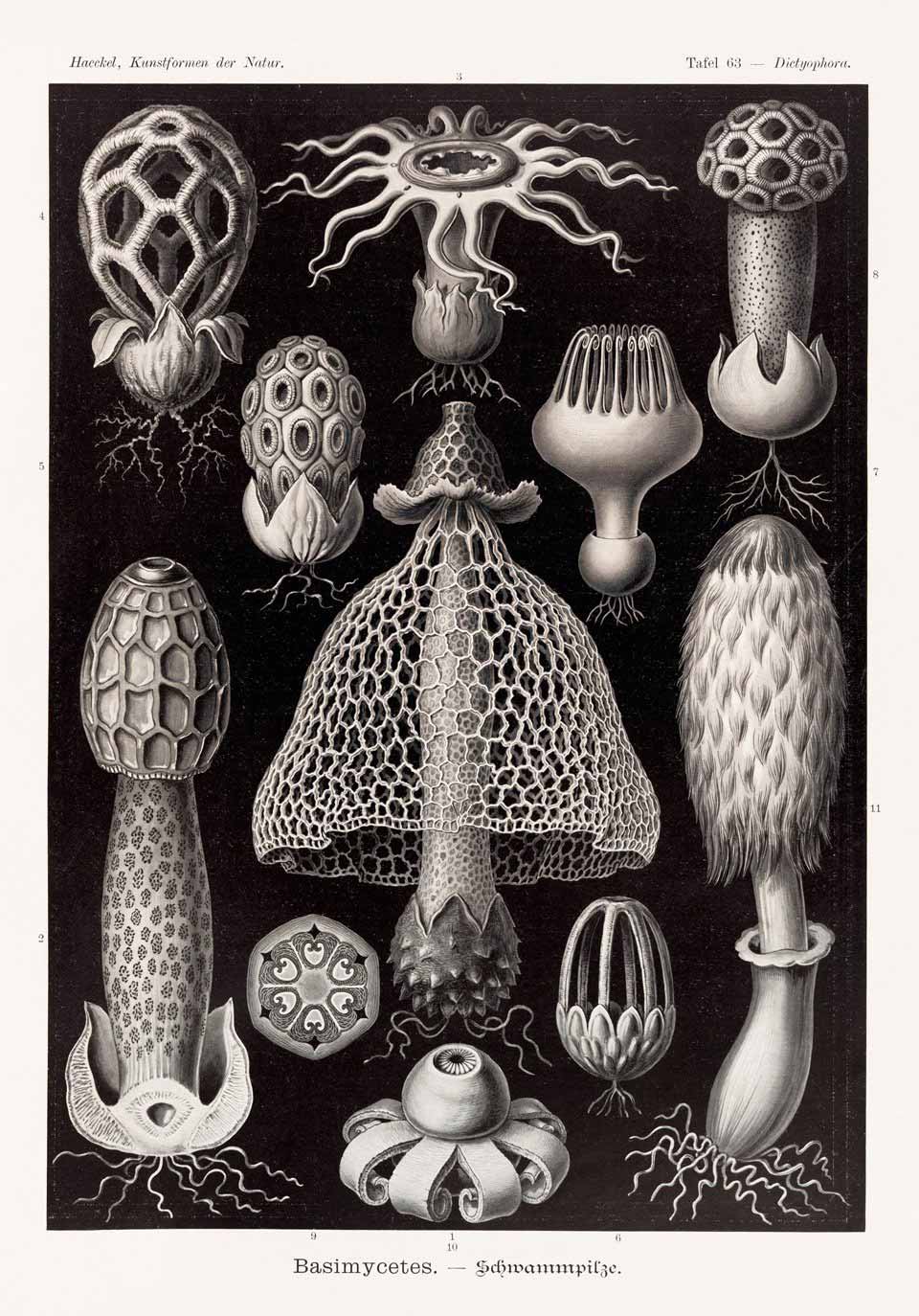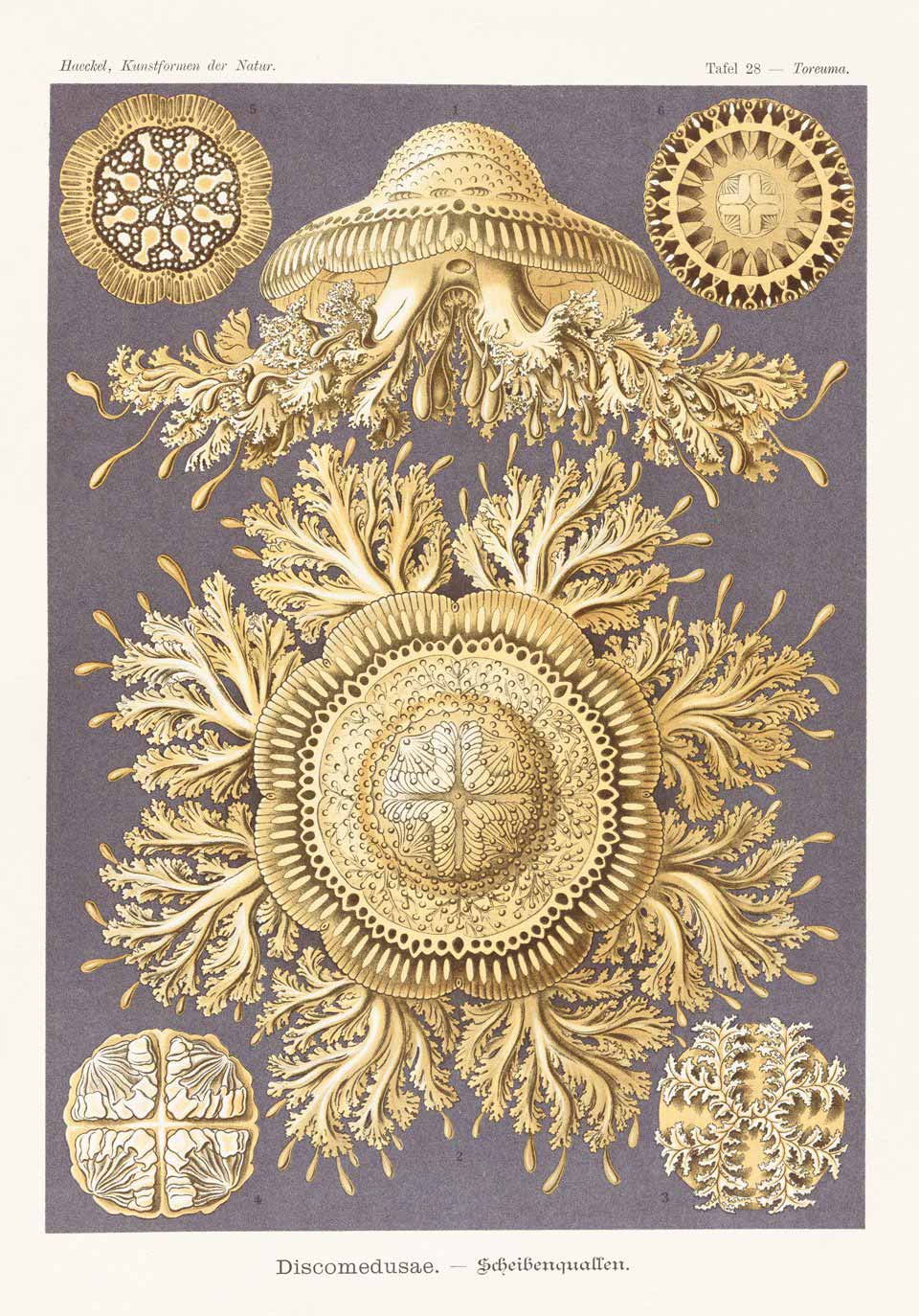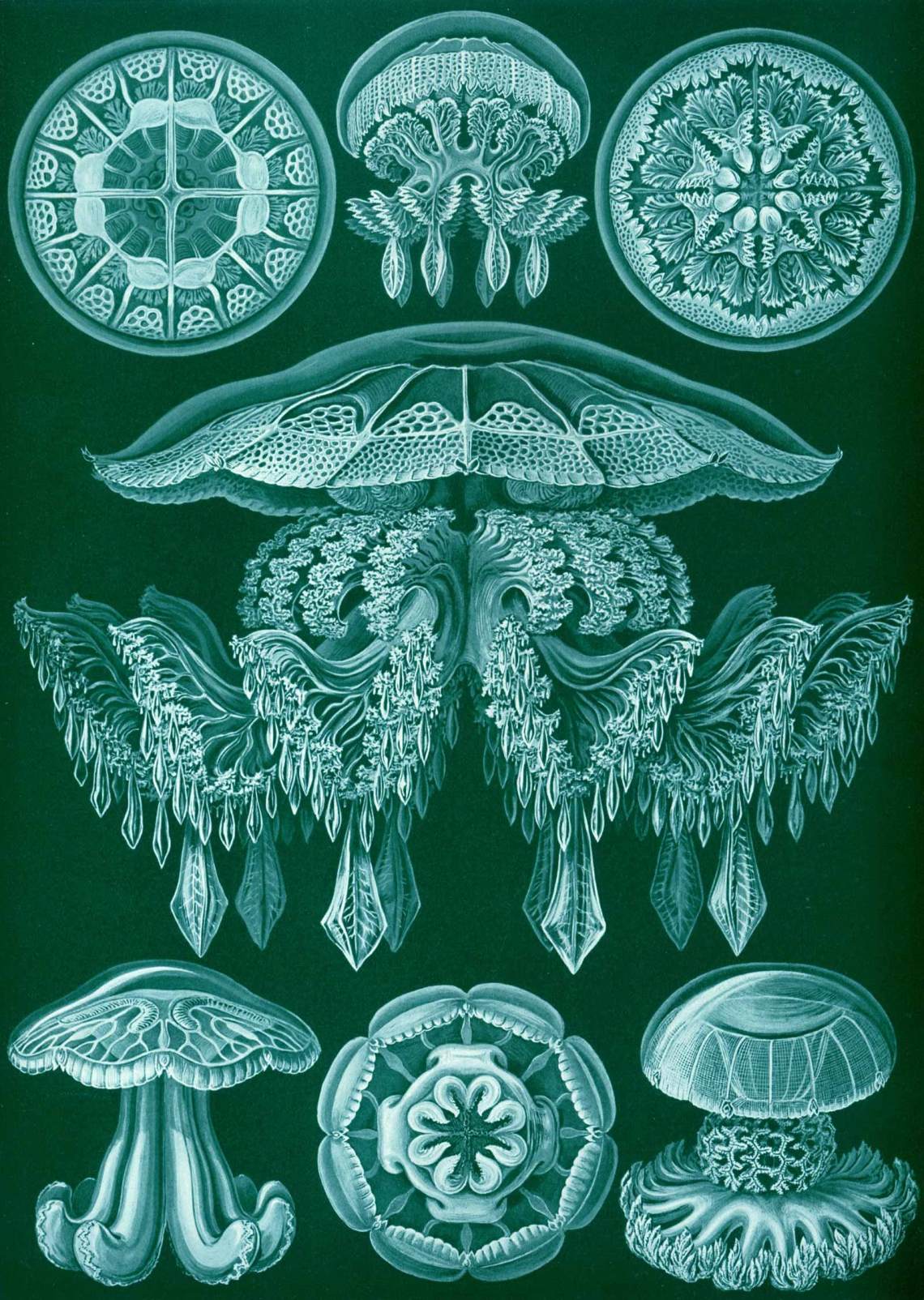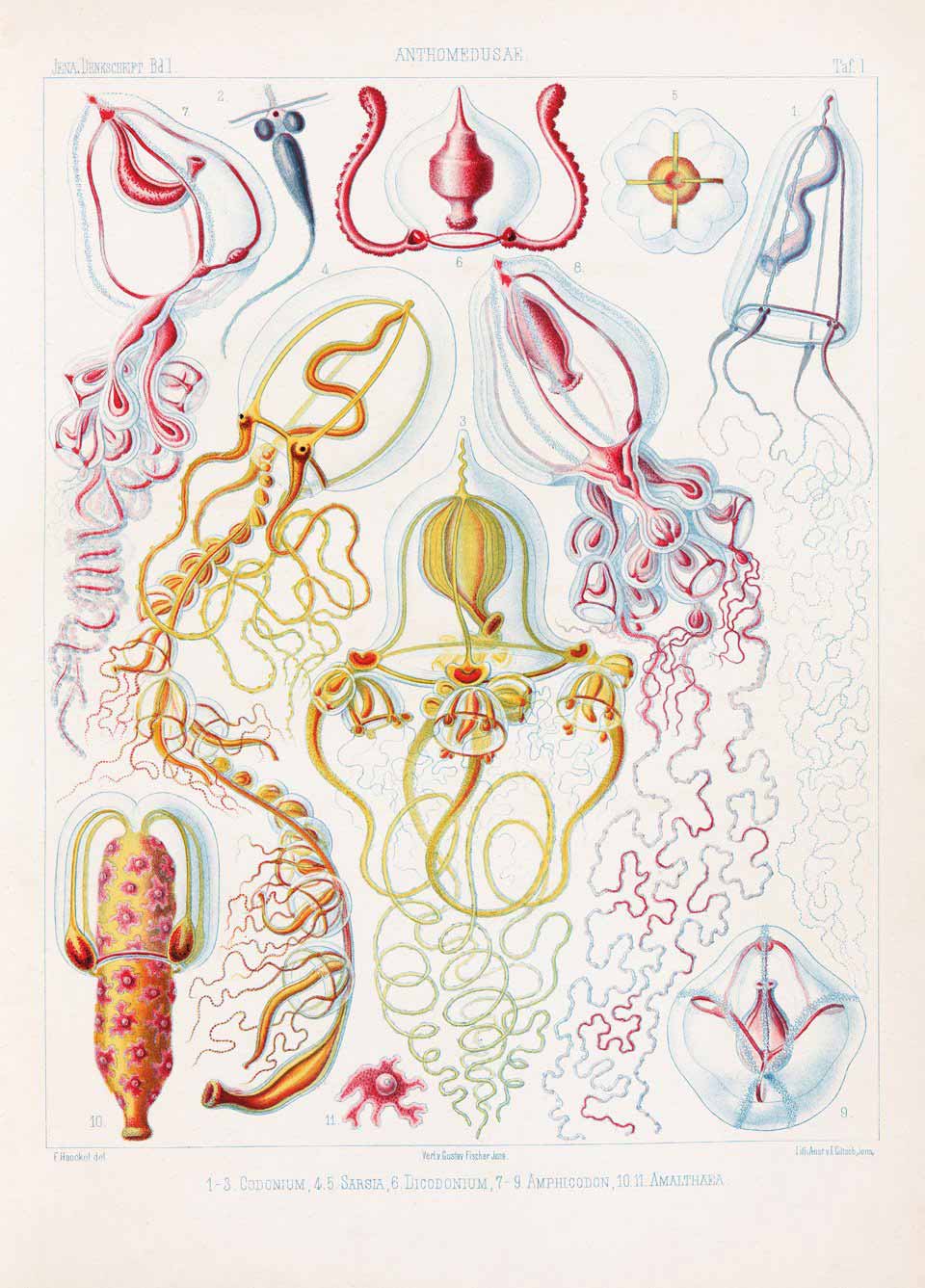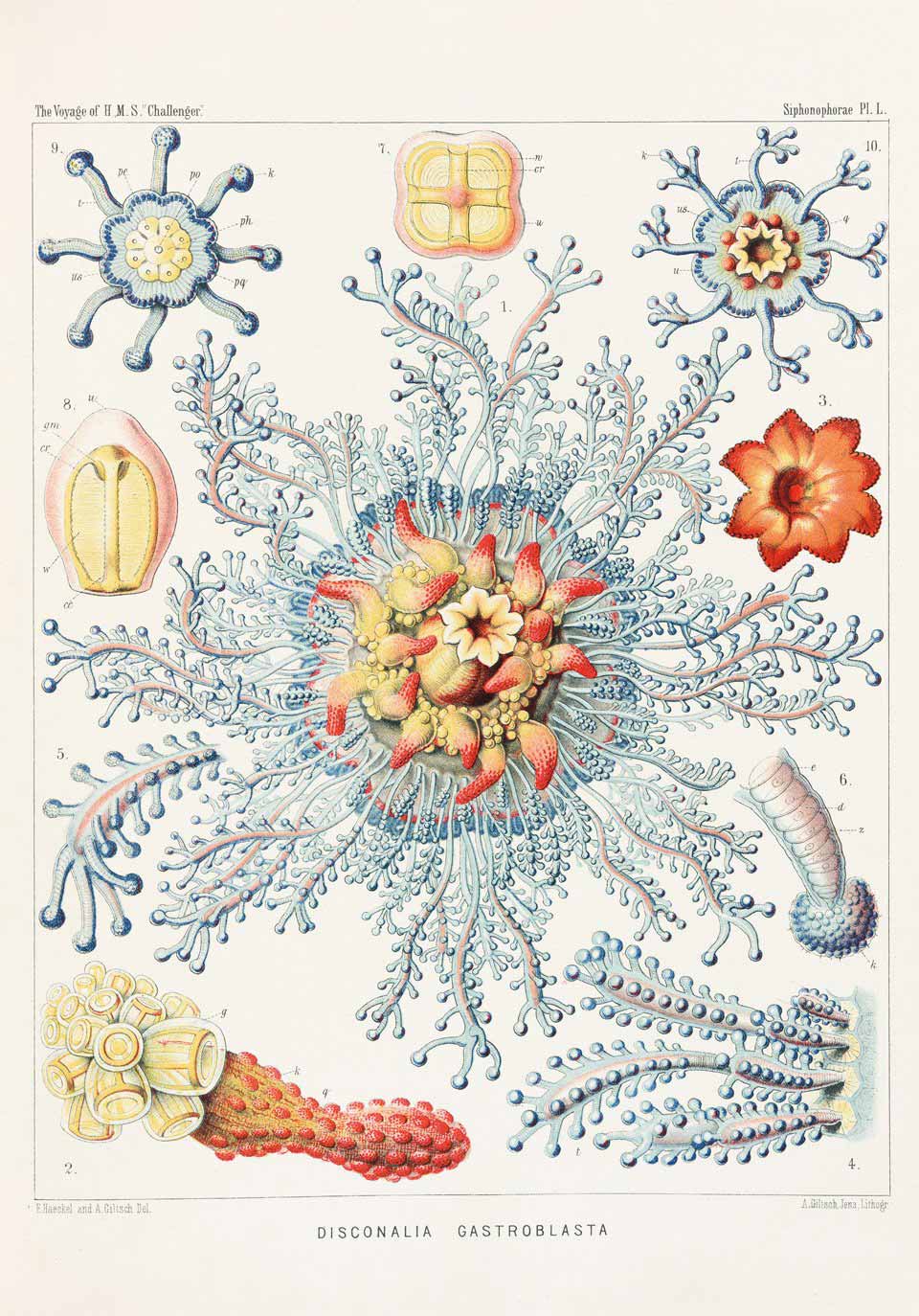In 1665, Robert Hooke published Micrographia, a small, illustrated treatise on the world seen through his simple compound microscope. Most of his subjects could be found on the kitchen table: the mold on a piece of cheese, the weave of the tablecloth, the cells in a sliver of cork. His most famous image is of a magnified flea. His engravings captivated and unnerved the public; the kitchen table was forever changed.
Two hundred years later, twenty-five-year-old Ernst Haeckel paddled a rowboat through the Gulf of Messina, sieving zooplankton with a fine mesh net, and writing home to his fiancée with as much excitement as if he were panning for gold. Armed with a x1,000 microscope, the best money could buy in 1859, he was cataloging radiolarians, taking up the study of his late mentor, Johannes Müller. Radiolarians are single-celled marine organisms named for their radial forms, of between a tenth and two tenths of a millimeter in diameter, and armored by silicate skeletons as variable as snowflakes.
Haeckel’s name has not endured as well as the words that he coined—among them, phylum, ecology, and stem cell. Yet he was a giant of nineteenth-century scientific thought, and responsible for the contagious spread of Darwin’s theory of evolution in Germany. An atheist iconoclast, he took up a crusade against religious dogma in scientific fields, tearing a rift between fundamentalist faith and Darwinism that rages today. His take on evolutionary theory, known as the biogenetic law or recapitulation, suggested that the evolution of a species was reflected in the individual’s embryonic development; the similarities between embryos of different species might point to their common ancestral origin. His research led him to speculate on human origins, and he was the first to draw out trees of evolutionary relationships between species. Recapitulation was a flawed concept, and so were Haeckel’s ideas about racial hierarchy, which the Nazis would readily co-opt. His evolutionary trees look like oaks, because Haeckel was also an artist, and the quality of the visuals was important to him.
A new book by Taschen has gathered the art from Haeckel’s monographs on the taxonomy and anatomy of marine organisms. Both art book and textbook, The Art and Science of Ernst Haeckel is coauthored by Rainer Willmann and Julia Voss, specialists in phylogenetics and German art history, respectively. Under its weight of fourteen pounds, my arms were jelly after hauling it home. But anything lighter would not do justice to the prolific output of Haeckel’s career.
It was while preparing his research on radiolaria that Haeckel read On the Origin of Species in translation. In the varying forms and complexities of the radiolarians, Haeckel saw evidence for the diversification of species. His first book, Monographie der Radiolarien, was published in 1862, complete with thirty-five sumptuously engraved plates based on his drawings of 144 new species he had observed on his trip to Italy; with one eye to the microscope and one hand sketching what he saw, the speed and perfectionism of his renderings are extraordinary. The book, published for a mass audience, was a great success in Germany and abroad. The anatomist Max Schultze wrote of Radiolarien, “I find myself undecided as to whether to feel more astonished by nature itself and its capacity to bring forth such diversity and beauty of forms, or by the hand of the draughtsman in his ability to capture such magnificence on paper.” The monograph earned Haeckel a professorship at the University of Jena, a post from which he would champion Darwinism through lectures and his bestselling 1868 book, Natürliche Schöpfungsgeschichte (The History of Creation).
In the midst of his early triumphs, Haeckel was devastated by the premature death of his wife, Anna Sethe. In his grief, he turned to the observation of tide pools, christening two jellyfish after her: Mitrocoma annae and Desmonema annasethe, particularly elegant species whose tentacles looked to Haeckel like curling tendrils of blond hair. Annasethe was shipped to him from Africa, preserved in wine in a tin. From the crumpled brown specimen, he reconstructed the shimmering tropical flower that is arguably his most famous image. On the lithographic plate, he fudged the size ratios so that it would be the largest of the three species. Haeckel’s prioritization of style and symbolism over strict accuracy may have corrupted the scientific value of his diagrams, but it elevated them into art.
Advertisement
Haeckel nurtured a lifelong affinity for painting landscapes, though Voss remarks that they lack the originality of his later monographs. His realist approach to biodiversity was not so different from his approach to landscapes; it’s just that naturalistic landscapes are a cliché, while jellyfish are cool and weird. Despite their baroque stylings, Haeckel’s monographs are anatomically very accurate. His mastery of chiaroscuro brought visual clarity and dimensionality to his subjects that were impossible to achieve by photography, especially with its black-and-white limitations at the time. What makes his images so useful to artists is that they’re mostly untampered-with; Haeckel seems to have had no pretensions that he could make anything more beautiful than nature already had, modestly claiming to be “no accomplished artist, but only an enthusiastic dilettante whose moderate talent, through extensive practice and heartfelt dedication, has been directed usefully to nature.” Haeckel had wanted to illustrate a plate on the evolution of humans, with the likeness of his mistress, Frida von Uslar-Gleichen, surrounded by the greater apes, but he doubted his ability to do her artistic justice. Instead, he dedicated a majestic jelly in her honor, Rhopilema frida, that since its publication has inspired a bloom of tentacled chandeliers from sculptors and craftsmen.
In Kustformen der Natur (Art Forms in Nature), 1899, science was put in the service of art. Haeckel believed that evolution would unite science with art and philosophy under one discipline, through which humans could reach a greater understanding of their world. His intention was to make the natural forms of elusive organisms accessible to artists, and supply them with a new visual vocabulary of protists, mollusks, trilobites, siphonophores, fungi, and echinoderms. Opening Art Forms, which is excerpted in The Art and Science, is like stepping into a cathedral, a place crafted by human hands that nonetheless inspires awe of the divine. Within are jellyfish that look like flowers, protists that resemble Fabergé eggs, presented like crown jewels on black velvet, the seeming cosmic vastness of the images belying their actual, microscopic size.
Artists took heed. Art Nouveau is crowded with the natural arabesques and patterns that seduced Haeckel. The crystalline structures of radiolaria made their way into the architecture of Antoni Gaudí, René Binet, and visibly into Bruno Taut’s Alpine Architecture, which imagined radiant utopian cities built of crystal and glass (one of Haeckel’s weirder treatises postulated that crystals possessed souls). The fluid forms of jellyfish charmed Klimt, whose women seem to swim across the canvas. Ghostly embryos haunt the works of Munch. The Surrealists found inspiration not only in the beauty of Haeckel’s images but in the darkness underlying them; Max Ernst’s biological distortions invoked an evolution toward not beauty but perversion.
Haeckel’s images are still referenced by contemporary artists like Philip Taaffe and Thomas Nozkowski. Still more artists have embraced his larger, cross-disciplinary project—such as Jen Bervin, who uses the structure of DNA in her poetry to explore the life cycles of silk worms; Lauren Redniss, whose illustrated books on science blend art, history, and lyric essay; and, of course, the musician Björk, whose album Biophilia makes emotional metaphors of plate tectonics and viruses, and who is rarely seen without a handcrafted Haeckelian tendril glued to her face. To see protists in our pop culture still strikes us as distinctively modern—although the organisms are ancient, only recently were we formally introduced.


